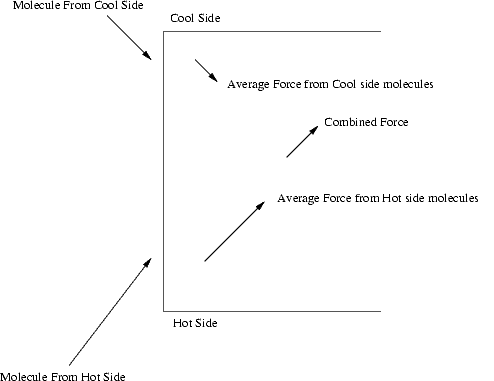Talk:Crookes radiometer
|
|
The "actual explanation" given is the one given in Britannica and is itself wrong.
In fact, it has always been wrong. Crookes said it was radiation pressure. Maxwell was pleased that it demonstrated a prediction of his theory of electromagnatism. Maxwell was embarassed to discover the explanation was incorrect. The theory given here was put forward, and, wary of making another mistake Maxwell checked it and found it to be incorrect also. This is easy to see: Imagine the glass to be shrunk so that it is only just big enough to allow the vanes to move, with no gap between vanes and glass (and a frictionless surface). Hold the vanes from moving. Shine light on the vanes. Hotter at black side, cooler on white side. Pressure equalises between the vanes (or the gas would move). After allowing the device to reach equilibrium there is no overall force. Let go: nothing happens. The correct solution was discovered by Osbourne Reynolds and is called thermal transpiration and is due to assymetric effects as molecules bounce off the *edge* of the vanes in the presence of the temperature gradient. This effect could be tested by cutting holes in the vanes. According to the incorrect theory, this should produce less heating and less rotation, thermal transpiration says it will increase the rotation. s
- Added the explaination that I found in the books listed on the page. Hopefully it makes sense. Both books give a long and involved proof of the effect, but I tried to simplify the general idea. The only problem with the simplification is that it kind of ignores comparing the number of gas molecules hitting the surface. Jrincayc 14:07, 5 Sep 2003 (UTC)
Removed Text
The actual explanation has to do with temperature differentials between the two sides of the vanes. The blackened side, absorbing radiation, is slightly hotter than the silvered side.
The reason for the motion of the radiometer was determined by James Clerk Maxwell and Osborne Reynolds in the later portions of the 1800s. The effect occurs at the edges of the vanes. On the hot side, the gas molecules are moving with higher average speed than the gases on the cold side. When the hot molecules hit the edge of the vane, on average they will produce a force on the vane that is towards the cool side. When the cool molecules that are passing in the other direction hit the vane, they will on average produce a force that is towards the hot side. Since the average speed of the hot molecules is greater than the average speed of the cold molecules, there will be a force on the vane towards the cool side. See the diagram below for an illustration of the effect.
This effect, called thermal transpiration, gives the vanes their force away from the hot side and thus is the cause of the motion of the radiometer.
- This text was removed by 69.157.79.102. Jrincayc 13:08, 23 Sep 2004 (UTC)
Reynolds' force must be the stronger.
Whether the "bumps in the surface" provide the proper explanation isn't clear to me. However, the article concludes that it isn't clear whether the Einstein effect or the Reynolds' force is the stronger, whereas the external link to the explanation by Phillip Gibbs claims that the explanation by Reynolds is the correct one. The reference to Einstein must be to the photoelectric effect. This must be smaller, I think, since otherwise the radiometer would not reverse direction upon cooling. Only problem is that the explanation by Gibbs is still confusing (at least to this reader) about how the edge effect attributed to Reynolds and Maxwell actually works. (Comment by PhysicsObserver, 5 June 2005)

